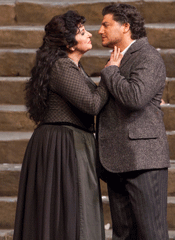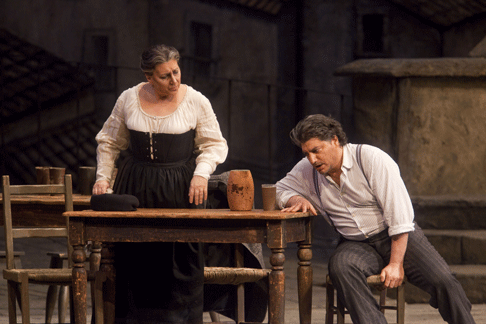No one was under par but there were very few surprises, few thrills or
chills. But each opera did conceal one surprise — one shock — one
small but significant vocal revelation — that made the evening other than
ordinary fare.
The spotlight on the curtain just before it rose on Franco
Zeffirelli’s almost too-accurate Sicilian mountain village drew from us
soft gasps of alarm, but it was just an announcement that JosÈ Cura, though
suffering from a cold, would be singing both leading tenor roles in any case.
(Domingo, his mentor, used to make such announcements all the time in the
’70s.) In the event, his opening serenade did indeed sound labored
— but when was the last time you heard any tenor, even in the pink of
health, sing that aria of sated love with an easy, leggiero line? For the rest
of the night he was fine, a bit gruff — as he usually is — and with
no ringing at the top, which some might miss. It’s a perfectly decent way
to put these parts over. Gigli fans will mourn, but he’s been dead a long
time.
 IldikÛ KomlÛsi as Santuzza and JosÈ Cura as Canio in Mascagni’s Cavalleria Rusticana.
IldikÛ KomlÛsi as Santuzza and JosÈ Cura as Canio in Mascagni’s Cavalleria Rusticana.
I was interested in the ladies of the evening. IldikÛ KomlÛsi sang the most
mellow-sounding Herodias of my experience last fall — no
eldritch screamer but a chic, handsome hostess having trouble controlling her
adolescent daughter — and I wondered how that enjoyable take on Strauss
would translate to Mascagni’s tormented peasant. KomlÛsi is a fine
actress, and hurled herself about the story and the stage, but her essentially
lyric instrument (though she also sings Amneris and Eboli, which call for
power) did not at first warm to its task, to the expression of desperation
— Santuzza is always on the verge of hysteria, she says nothing calmly,
she opens her mouth and her whole anguished life is in her utterances.
KomlÛsi’s beautiful voice and Germanic (okay, Hungarian) vibrato are
pleasing, but she did not become intense until the duets with Cura and Alberto
Mastromarino’s dry, not very threatening Alfio pushed her to forget
herself and go wild. Santuzza has tripped up many experienced singers; I did
not feel she had it quite down, but she is a voice and an artist of
interest.
No part is too small for Jane Bunnell to make it interesting — on such
character performers do repertory companies rely, and her dignified Mamma Lucia
was a pleasure. But then out came Lola, a youngster from the Met’s
Lindemann Young Artists’s Program, one Ginger Costa Jackson, tall, slim,
very pretty, a bit too whorish about the sashay (an error made by too many
Lolas — she’s a respectable wife in a prudish small town, and no
one but Santuzza suspects she’s anything else), but — the voice! No
light mezzo here (as one is used to), but a deep, penetrating, perfectly
produced contralto with exciting colors. She would make quite an effect in a
range of Handel roles, trouser or otherwise.
 Jane Bunnell as Mamma Lucia and JosÈ Cura as Canio in Mascagni’s Cavalleria Rusticana.
Jane Bunnell as Mamma Lucia and JosÈ Cura as Canio in Mascagni’s Cavalleria Rusticana.
The lady in Pagliacci — there’s only one, remember
— was Nuccia Focile, a charming soubrette in the past (an adorable
Despina in CosÌ fan tutte), who sang a mediocre Nedda, the voice
unsupported, the coloratura imprecise in both “Stridono lassu” and
the play-within-the-play. The only time she rose to the demands of this
curious, death-defying figure was during her impassioned love duet with Silvio
— and here was the evening’s second surprise: Christopher Maltman.
This striking and sexy British baritone, a noted lieder singer as well as a
Billy Budd and a specialist in Mozart roles, filled the house with an easy,
dark, focused, thrilling baritone and was an equally thrilling actor. Too, he
sang with the most perfect Italian enunciation of the night. This is a voice
with star quality and a rare musical intelligence, a singer one is eager to
hear again in a dozen roles or in recital. Beside him, Cura and Mastromarino,
the evening’s Canio and Tonio, sounded effective but ordinary —
they wrung no sobs from me.
Pietro Rizzo had a firm hand on the dramatic flow of the evening in the pit;
the resonant celli seemed especially to flower, and I clearly heard echoes of
Wagner in Pagliacci, whenever Tonio was conniving. The Zeffirelli
staging with all its animals and all its children and all its gradual dawn and
sunset lighting changes and all its clowning extras gives audiences a notion of
what grand opera used to be about, and why young directors have been so eager
to change it. A ringing Canio, a gutsy Santuzza and a real Nedda would make it
for me.
John Yohalem
image=http://www.operatoday.com/PAG-Cura-and-Focile_6839.gif
image_description=JosÈ Cura as Canio and Nuccia Focile as Nedda in Leoncavallo’s “Pagliacci.” [Photo by Ken Howard courtesy of The Metropolitan Opera]
product=yes
product_title=Pietro Mascagni: Cavalleria Rusticana
Ruggero Leoncavallo: Pagliacci
product_by=Cavalleria Rusticana — Santuzza: IldikÛ KomlÛsi; Mamma Lucia: Jane Bunnell; Lola: Ginger Costa Jackson; Turiddu: JosÈ Cura; Alfio: Alberto Mastromarino.
Pagliacci — Nedda: Nuccia Focile; Canio: JosÈ Cura; Tonio: Alberto Mastromarino; Silvio: Christopher Maltman.
Conducted by Pietro Rizzo. Metropolitan Opera, performance of April 2.
product_id=Above: JosÈ Cura as Canio and Nuccia Focile as Nedda in Leoncavallo’s Pagliacci.
All photos by Ken Howard courtesy of The Metropolitan Opera.